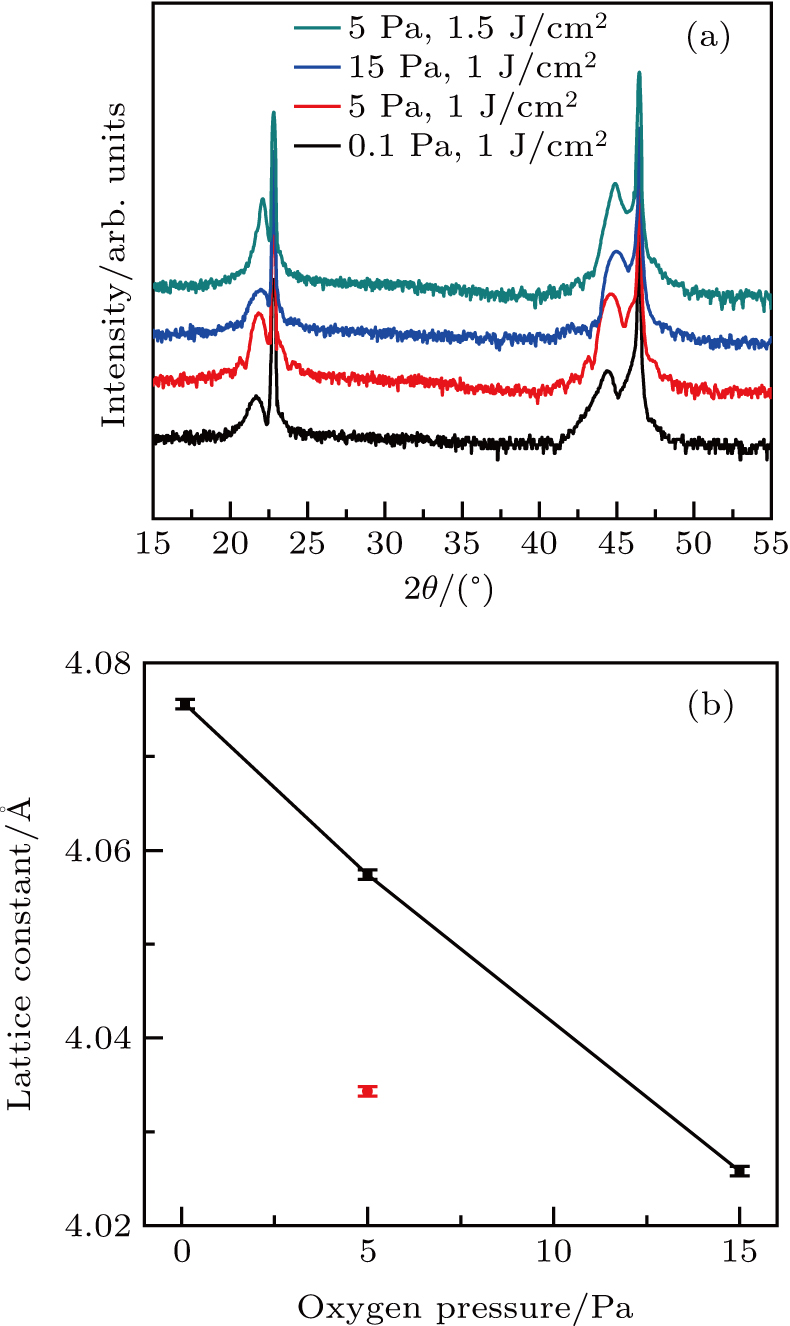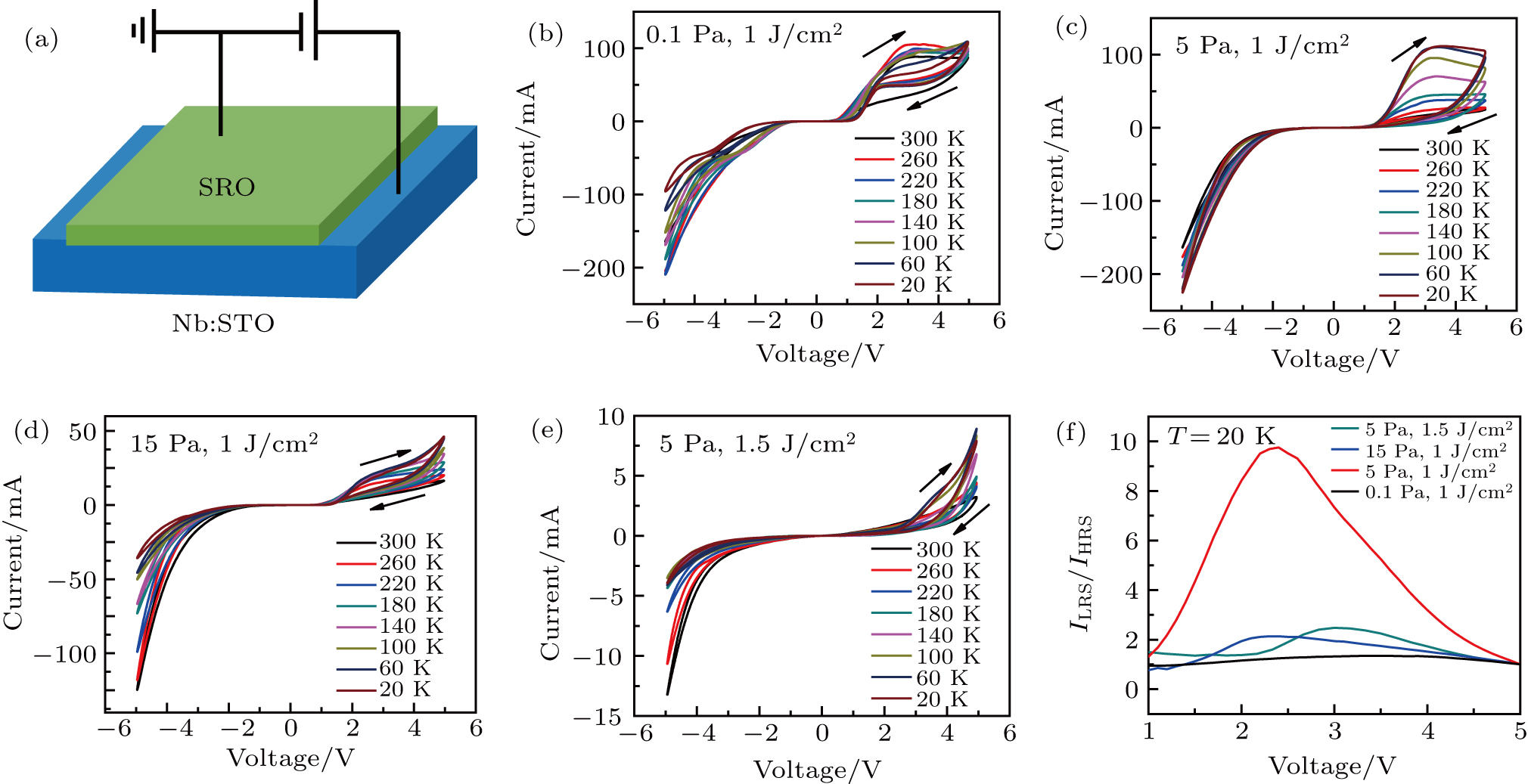† Corresponding author. E-mail:
Project supported by the National Natural Science Foundation of China (Grant Nos. 51627901 and 11574287), the National Key Research and Development Program of China (Grant No. 2016YFA0401004), and the Anhui Initiative in Quantum Information Technologies, China (Grant No. AHY100000).
Metal/semiconductor memristive heterostructures have potential applications in nonvolatile memory and computing devices. To enhance the performance of the memristive devices, it requires a comprehensive engineering to the metal/semiconductor interfaces. Here in this paper, we discuss the effects of oxygen vacancies and temperature on the memristive behaviors of perovskite-oxide Schottky junctions, each consisting of SrRuO3 thin films epitaxially grown on Nb:SrTiO3 substrates. The oxygen partial pressure and laser fluence are controlled during the film growth to tune the oxygen defects in SrRuO3 films, and the Schottky barrier height can be controlled by both the temperature and oxygen vacancies. The resistive switching measurements demonstrate that the largest resistance switching ratio can be obtained by controlling oxygen vacancy concentration at lower temperature. It suggests that reducing Schottky barrier height can enhance the resistive switching performance of the SrRuO3/Nb:SrTiO3 heterostructures. This work can conduce to the development of high-performance metal-oxide/semiconductor memristive devices.
In recent years, the memristive switching devices have received intensive attention for the applications in the resistive random access memories (RRAM) because of their many superiorities such as the simple structure, outstanding performance, low power consumption, and fast switching.[1] The memory effect has been achieved by the switching between the high resistance state (HRS, OFF state) and the low resistance state (LRS, ON state), modulated by the electrically unipolar or bipolar bias. Great efforts have been made to discover the microscopic origins of resistive switching, which is important for understanding this physical phenomenon and is the key point for further enhancing the resistive switching performance. A variety of resistive switching devices have been fabricated while the mechanisms responsible for the memristive behaviors are heavily disputed. It can be concluded that the possible mechanisms include ion migration and thermochemical reaction, metal-insulator transition, charge trapping or detraping, etc.[2–6] These findings highlight the way such as ion doping and defect engineering to enhance the memristive performance, in which the oxygen vacancies are extensively studied because of the ideal investigating platform provided by the transition-metal oxides.
Both of the binary and complex transition-metal perovskite oxides are widely used in the resistive switching devices due to the stable crystal structures and rich electronic properties.[7–16] Among them, SrRuO3 (SRO) is a ferromagnetic metal with a high work function and Nb:SrTiO3 (Nb:STO) is an n-type semiconductor.[17] The resistive switching behavior of SRO/Nb:STO heterostructures has been studied previously,[6] in which the Nb content was controlled and it was demonstrated that the dependence of electron charging in a self-trap on bias polarity leads to the resistive switching behavior, but how the oxygen vacancy concentration affects the resistive switching behavior has not been revealed. And the modulation of the Schottky barrier height to the memristive performance, which may determine the resistive switching behavior fundamentally, is still unclear.
In this work, we systematically study the effects of oxygen vacancy concentration and Schottky barrier height on the resistive switching behavior of SRO/Nb:STO heterostructures prepared by pulsed laser deposition (PLD) technique assisted with reflective high-energy electron diffraction (RHEED). During the film growth, we control the oxygen partial pressure and laser fluence to tune the oxygen vacancy concentration in the SRO film. Besides, the Schottky barrier height can be modulated by both the oxygen vacancy concentration and the temperature. The resistance switching measurements of SRO/Nb:STO heterostructures demonstrate that all the films exhibit resistive switching behaviors that depend strongly on the concentration of oxygen vacancies and the temperature, and the heterostructures exhibit the best memristive performance at a smaller Schottky barrier height. These findings may be instructive to the future development of resistive switching devices with high performance.
The SrRuO3 thin films, each with a thickness of ∼10 nm, were grown on (001)-oriented Nb:SrTiO3 single-crystal substrates with Nb doping of 0.7 wt% by the PLD. A KrF excimer laser beam (λ = 248 nm) was focused onto the SRO target at a repetition rate of 1 Hz, and the laser fluence was 1 J/cm2 and 1.5 J/cm2 separately. The substrate temperature was ∼700°C in the whole deposition process. The oxygen pressures in the growth chamber were 0.1 Pa, 5 Pa, and 15 Pa respectively. After being deposited, the films were cooled down to room temperature under an oxygen pressure of 100 Pa. The x-ray diffraction (XRD) analysis was performed by using a Rigaku 4-circle diffractometer with a Cu Kα anode radiation (wavelength of 1.5406 Å) to investigate the structural quality and lattice constants of SRO films. The temperature-dependent current–voltage (I–V) characteristics in a range from 300 K to 20 K were measured by a quantum design physical property measurement system (PPMS) and a Keithley 2400 Source Meter, in which the DC voltage was applied to the samples and the electric currents were measured. The films and substrates were connected by gold wires and silver paste. The Ru M-edge and O K-edge soft x-ray absorption spectrum (XAS) measurements were performed at beamline BL12B-a at the National Synchrotron Radiation Laboratory of China (NSRL).
During the film growth, the ambient oxygen partial pressure and the laser fluence are varied to control the oxygen vacancy density in SRO films. Three groups of SRO thin films are grown under oxygen partial pressures of 0.1 Pa, 5 Pa, and 15 Pa with a laser fluence of 1 J/cm2 respectively and one group of SRO thin films were grown at 5 Pa with a laser fluence of 1.5 J/cm2. Figure 
Figure 
Figure
To verify the change of oxygen vacancy concentration in the SRO films prepared at different oxygen pressures and laser fluence, we perform the Ru M-edge and O K-edge x-ray absorption spectrum measurement. Figure
To check whether the Schottky barrier height (illustrated in Fig.







In this work, we systematically study the effects of the oxygen vacancy concentration and Schottky barrier height on the resistive switching behavior of SRO/Nb:STO heterostructures. The XRD and XAS measurements demonstrate that the oxygen vacancy concentrations in the SRO films are reduced by increasing the growth oxygen partial pressure and laser fluence. The fitting of the rectifying I–V characteristics of the films by using the thermionic emission theory shows that the Schottky barrier height decreases with temperature lowering. The temperature dependent resistive switching measurements demonstrate the performance of the SRO/Nb:STO junctions can be enhanced by modulating the oxygen vacancy concentration and temperature. The resistive switching behavior of the SRO/Nb:STO junctions can be driven by the migration of oxygen ions or the charging effect at the Schottky interface. Both mechanisms are closely related to the oxygen vacancy concentration and Schottky barrier height. Our results could be instructive to future develop the high-performance resistive switching metal-oxide/semiconductor devices.
| [1] | |
| [2] | |
| [3] | |
| [4] | |
| [5] | |
| [6] | |
| [7] | |
| [8] | |
| [9] | |
| [10] | |
| [11] | |
| [12] | |
| [13] | |
| [14] | |
| [15] | |
| [16] | |
| [17] | |
| [18] | |
| [19] | |
| [20] | |
| [21] | |
| [22] | |
| [23] | |
| [24] | |
| [25] | |
| [26] | |
| [27] | |
| [28] |







